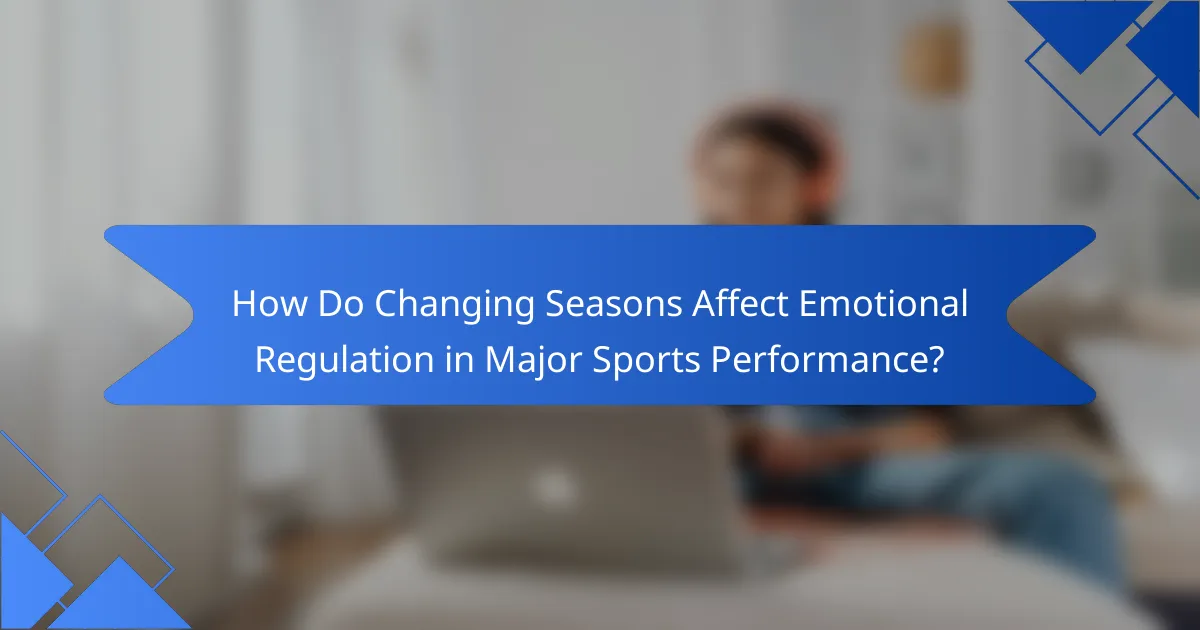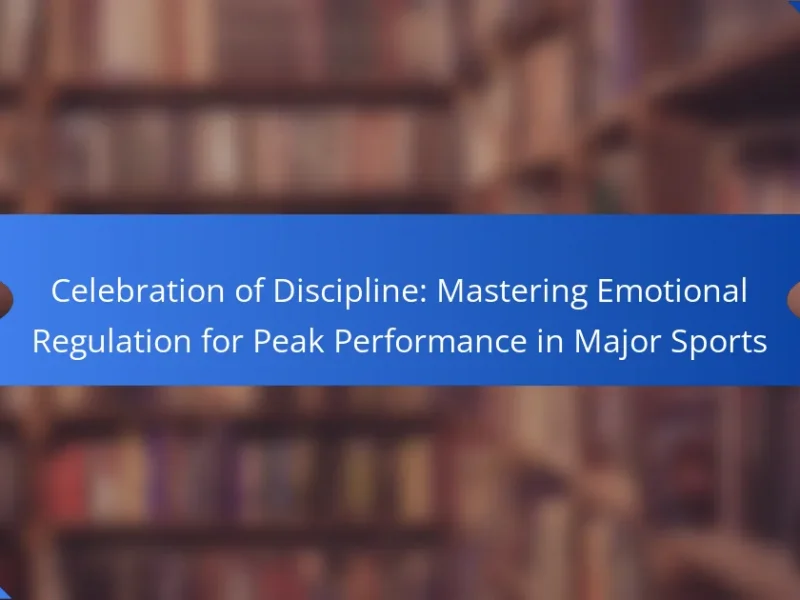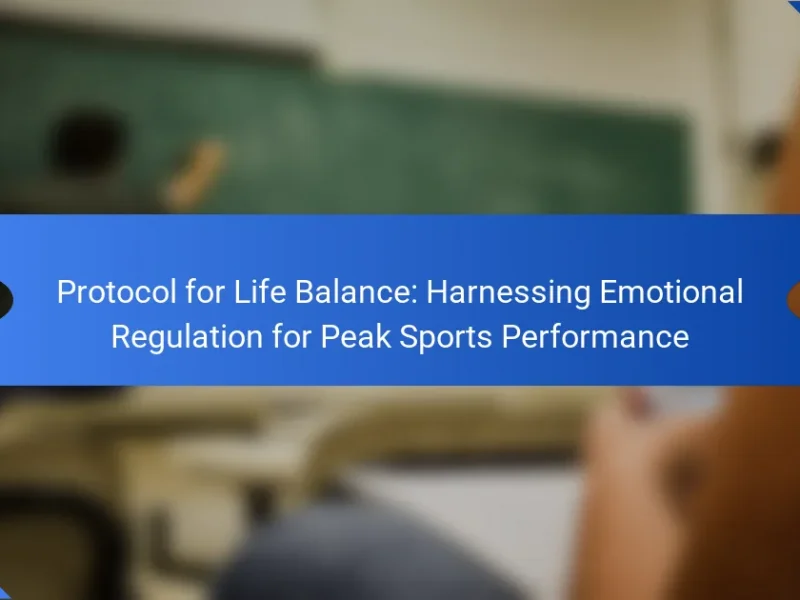Changing seasons significantly impact emotional regulation, which is crucial for major sports performance. Seasonal variations can alter athletes’ mood and motivation, influencing their overall mental state. Research shows winter months often lead to decreased energy and focus due to reduced sunlight, while spring and summer typically enhance motivation. Strategies like light therapy, mindfulness training, and flexible training schedules can help athletes manage these emotional fluctuations effectively.

How do changing seasons influence emotional regulation in major sports performance?
Changing seasons significantly influence emotional regulation in major sports performance. Seasonal variations affect athletes’ mood, motivation, and overall mental state, impacting their performance levels.
Research indicates that winter months can lead to increased feelings of depression due to reduced sunlight exposure, affecting athletes’ energy and focus. Conversely, spring and summer often bring elevated moods and enhanced motivation, contributing to improved performance.
Unique attributes such as seasonal affective disorder (SAD) can specifically hinder emotional regulation in athletes during colder months. As a result, teams may implement strategies to mitigate these effects, such as light therapy or modified training schedules.
Understanding these seasonal influences enables coaches and athletes to optimize mental health and performance throughout the year.
What are the universal effects of seasonal changes on athlete emotions?
Seasonal changes significantly influence athlete emotions, affecting performance and emotional regulation. For example, winter often brings feelings of isolation, while summer can enhance mood and motivation. Studies show that athletes may experience increased anxiety during transitions between seasons, impacting training consistency. Seasonal affective disorder (SAD) is a unique attribute affecting some athletes, leading to decreased performance in winter months. Understanding these emotional shifts helps coaches and athletes develop strategies to maintain mental well-being throughout the year.
How do temperature variations impact mood and performance?
Temperature variations significantly influence emotional regulation and performance in major sports. Seasonal changes can affect athletes’ mood, energy levels, and overall mental state. For instance, colder months may lead to decreased motivation and increased feelings of fatigue, while warmer seasons often boost energy and enthusiasm.
Research indicates that athletes may experience seasonal affective disorder (SAD), particularly in winter, leading to diminished performance. In contrast, spring and summer can enhance mood and improve training outcomes. Additionally, temperature extremes can impact physical performance, with heat potentially causing fatigue and cold affecting muscle function.
Understanding these dynamics allows coaches and athletes to adapt training regimens to optimize performance throughout the year. By recognizing the emotional and physical effects of temperature changes, athletes can better manage their mental health and maintain peak performance.
What role does daylight duration play in emotional stability?
Daylight duration significantly influences emotional stability by affecting mood and energy levels. Longer daylight hours correlate with improved emotional regulation, enhancing performance in major sports. Studies show that athletes experience reduced anxiety and increased motivation during extended daylight, leading to better outcomes. Seasonal changes impact serotonin levels, which are crucial for emotional well-being. Optimizing exposure to natural light can therefore improve both psychological health and sports performance.
What unique emotional challenges do athletes face in different seasons?
Athletes face unique emotional challenges in different seasons due to varying environmental conditions and competition schedules. Seasonal changes can impact mood and motivation, influencing performance. For instance, winter may bring seasonal affective disorder, while summer heat can lead to fatigue and irritability. These emotional fluctuations require athletes to develop adaptive emotional regulation strategies to maintain peak performance throughout the year. Research indicates that athletes who effectively manage emotional responses tend to achieve better outcomes in their sports.
How does winter affect motivation and team dynamics?
Winter can decrease motivation and disrupt team dynamics due to lower daylight and colder temperatures. Seasonal affective disorder (SAD) affects many individuals, leading to reduced energy and engagement. Teams may experience decreased collaboration and communication, as members feel less inclined to participate in group activities. To counter these effects, organizations can implement strategies such as flexible schedules and team-building exercises to enhance morale and maintain performance.
What specific emotional responses are triggered during the summer season?
Summer triggers feelings of joy, increased energy, and relaxation, influencing emotional regulation in sports performance. The warmth and longer days promote outdoor activities, enhancing mood and motivation. Research shows athletes often experience heightened enthusiasm and focus during summer, impacting their training and competition outcomes positively. This seasonal shift can lead to increased team cohesion and social interactions, further boosting performance.
What rare emotional regulation strategies are employed by elite athletes?
Elite athletes employ rare emotional regulation strategies such as mindfulness meditation, biofeedback training, and visualization techniques. These methods help manage stress and enhance focus, particularly during seasonal transitions that affect performance. For example, mindfulness meditation cultivates awareness of emotional states, allowing athletes to respond rather than react. Biofeedback training provides real-time data on physiological responses, enabling athletes to regulate emotions effectively. Visualization techniques help athletes mentally rehearse performance scenarios, reducing anxiety and improving confidence. These strategies contribute to maintaining peak performance throughout changing seasons.
How do some athletes adapt their training to seasonal emotional shifts?
Athletes adapt their training to seasonal emotional shifts by modifying their routines and mental strategies. During winter months, they may focus on indoor training to combat seasonal affective disorder, while summer allows for outdoor activities that enhance mood.
Research indicates that athletes often implement mental conditioning techniques, such as visualization and mindfulness, to maintain emotional balance throughout the year. These practices help them cope with stressors associated with competitive seasons.
Additionally, training schedules may be adjusted to align with seasonal changes, optimizing performance and emotional well-being. For example, athletes might increase social interactions in warmer months to boost morale, while using solitude in winter for focused training.
In summary, seasonal emotional shifts significantly influence athletes’ training adaptations, emphasizing the importance of mental health in sports performance.
What uncommon techniques help athletes maintain focus during seasonal transitions?
Athletes can maintain focus during seasonal transitions by employing techniques such as mindfulness meditation, visualization, and structured routines. Mindfulness meditation enhances emotional regulation, allowing athletes to stay present. Visualization helps in mentally preparing for varying conditions. Structured routines provide stability amidst change, fostering consistency in performance.

How can coaches support emotional regulation throughout the seasons?
Coaches can support emotional regulation by fostering resilience and adaptability as seasons change. They can implement strategies like mindfulness training, consistent communication, and individualized support to help athletes manage emotional fluctuations.
Seasonal transitions can impact mood and motivation. Coaches should monitor athletes’ mental health, providing resources such as counselling or stress management workshops. Encouraging team bonding activities can also strengthen emotional connections, enhancing overall performance.
Regular feedback is essential. Coaches should create an environment where athletes feel safe to express emotions. This open communication allows for timely interventions, helping athletes navigate seasonal challenges.
Additionally, incorporating flexibility in training schedules can accommodate athletes’ emotional needs. This adaptability can lead to improved focus and performance during critical competition periods.
What best practices should coaches implement for seasonal emotional management?
Coaches should implement strategies such as regular emotional check-ins, mindfulness training, and seasonal goal setting. These practices enhance athletes’ emotional regulation throughout seasonal changes.
Regular emotional check-ins help identify mood fluctuations and provide support. Mindfulness training fosters awareness, enabling athletes to manage stress effectively. Seasonal goal setting aligns athletes’ focus with changing conditions, promoting motivation and resilience.
As a result, these best practices create a supportive environment, enhancing overall sports performance and emotional well-being.
How can team-building activities be tailored to seasonal emotional needs?
Team-building activities can be tailored to seasonal emotional needs by aligning them with the psychological impacts of each season. For instance, spring often brings renewal and energy, making it ideal for outdoor activities that foster teamwork. In contrast, winter may evoke feelings of isolation; thus, indoor activities that emphasize collaboration and support can be beneficial.
Understanding the unique attributes of each season helps in designing activities that resonate emotionally. For example, summer can focus on fun and relaxation, while autumn can encourage reflection and gratitude. By considering these seasonal emotional dynamics, teams can enhance cohesion and performance throughout the year.
What role does communication play in supporting athletes’ emotional well-being?
Communication plays a vital role in supporting athletes’ emotional well-being, especially during changing seasons. Effective communication fosters a supportive environment, helping athletes express their feelings and concerns. This dialogue can mitigate stress and anxiety linked to performance fluctuations influenced by seasonal changes. Additionally, regular check-ins and feedback enhance emotional regulation, allowing athletes to adapt better to the mental demands of their sport. Engaging in open conversations can lead to stronger team cohesion, which is crucial for maintaining morale throughout the competitive season.
What common mistakes do teams make regarding emotional regulation in different seasons?
Teams often overlook seasonal impacts on emotional regulation, leading to performance inconsistencies. Common mistakes include failing to adapt training schedules to seasonal mood changes, neglecting mental health resources, and underestimating the influence of weather on athlete morale. For example, winter months may increase feelings of isolation, affecting team cohesion. As a result, teams may struggle to maintain motivation and focus during critical competitions. Implementing strategies for emotional support tailored to each season can enhance overall performance.
What expert insights can enhance emotional regulation in major sports?
Changing seasons significantly impact emotional regulation in major sports performance. Seasonal variations can influence athletes’ mood, motivation, and overall mental health.
Research indicates that winter months often lead to increased feelings of depression and fatigue due to reduced sunlight exposure, affecting training consistency. Conversely, spring and summer typically enhance mood and energy levels, promoting better performance.
Athletes can enhance emotional regulation by adopting strategies such as mindfulness, which has been shown to improve focus and emotional resilience. Additionally, maintaining a balanced routine that includes physical activity, social interactions, and proper nutrition can mitigate seasonal mood fluctuations.
Coaches should be aware of these seasonal effects and provide support to help athletes adapt, ensuring optimal performance throughout the year.


